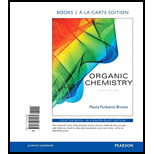
Concept explainers
(a)
Interpretation:
To identify which of the given reaction is not feasible.
Concept introduction:
The
(b)
Interpretation:
To identify the reactions which are not feasible in the above part of the question can be made feasible by adding an acid catalyst.
Concept introduction:
The aminolysis reaction and the hydrolysis of ester can be made feasible by the addition of acid catalyst in the reaction mixture.
The acid catalyst first protonates the carbonyl oxygen thus increses the electrophillitcity of the carbonyl carbon and also protonates the nitogen atom making it good leaving group. Thus, the
Want to see the full answer?
Check out a sample textbook solution
Chapter 15 Solutions
Organic Chemistry, Books a la Carte Edition (8th Edition)
- Draw the major organic product of the following reaction. Do not draw inorganic byproducts. conc. H2SO4arrow_forwardWhat is the major difference between the base-catalyzed and acid-catalyzed processes for nucleophilic addition of water to aldehydes and ketones? a. The base-catalyzed reaction takes place rapidly because hydroxide ion is a much better nucleophile than neutral water. b. The rate of reaction in base catalyzed process is slower than acid catalyzed process. c. The acid-catalyzed reaction takes place rapidly because the protonated carbonyl compound is a much better electrophile than the neutral compound. d. Only 1 and 3 are correct.arrow_forwardWhat product will be made with aqueous acid?arrow_forward
- Draw a stepwise mechanism for the following reaction. This reaction combines two processes together: the opening of an epoxide ring with a nucleophile and the addition of an electrophile to a carbon–carbon double bond. (Hint: Begin the mechanism by protonating the epoxide ring.)arrow_forwardDraw the product formed when A is treated with below series of reagents. [1] H2O; [2] NaH; [3] CH3Brarrow_forwardWhich reaction intermediate (A or B) is more likely to form in the epoxide ring opening reaction? Reactions prefer to react through lower energy intermediates. Hint: how might you justify one structure being lower in energy than the other? Draw structures as part of your explanation why. Structure A Structure B ерoxide ring opening HO, : ОН Which alcohol structure shown below would be less acidic? Explain why. F F. Br Br Brarrow_forward
- List the appropriate reagents that can be used in places with question marks in the following series of reactions.arrow_forwarda,B-Unsaturated aldehydes and ketones can undergo reaction with nucleophiles at the B carbon, as shown below. Draw a resonance form for the unsaturated carbonyl that accounts for this reactivity.arrow_forward15. provide the missing reagents for the following reactionarrow_forward
- Which statement is incorrect? A Grignard reagent is a strong lewis base a. O b. Water and alcohol decompose Grignard reagents Oc. Grignard reagents add to the carbonylic carbon of a ketone or aldehyde Ether and THF are solvents not suited for Grignard reactions. d.arrow_forwardDraw a stepwise mechanism for the following reaction. This reactioncombines two processes: the opening of an epoxide ring with anucleophile and the addition of an electrophile to a carbon–carbondouble bond. (Hint: Begin the mechanism by protonating the epoxidering.)arrow_forwardPlease give the appropriate reagents to complete the following synthesis.arrow_forward
 Organic Chemistry: A Guided InquiryChemistryISBN:9780618974122Author:Andrei StraumanisPublisher:Cengage Learning
Organic Chemistry: A Guided InquiryChemistryISBN:9780618974122Author:Andrei StraumanisPublisher:Cengage Learning Organic ChemistryChemistryISBN:9781305580350Author:William H. Brown, Brent L. Iverson, Eric Anslyn, Christopher S. FootePublisher:Cengage Learning
Organic ChemistryChemistryISBN:9781305580350Author:William H. Brown, Brent L. Iverson, Eric Anslyn, Christopher S. FootePublisher:Cengage Learning


